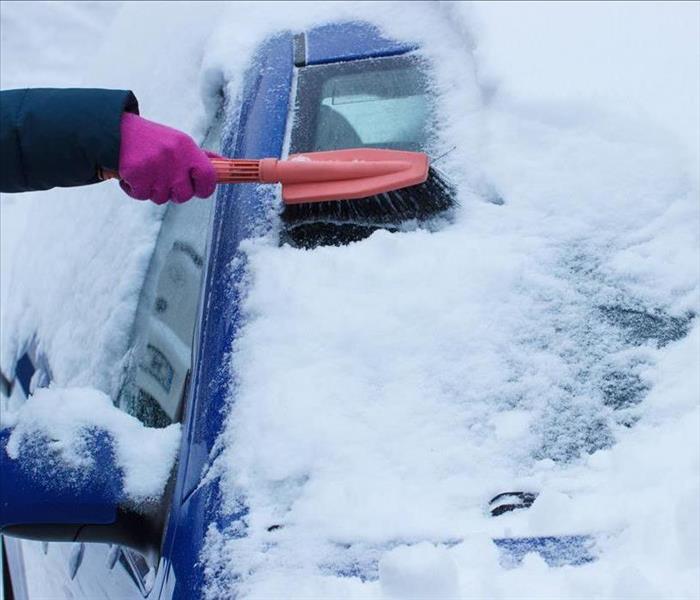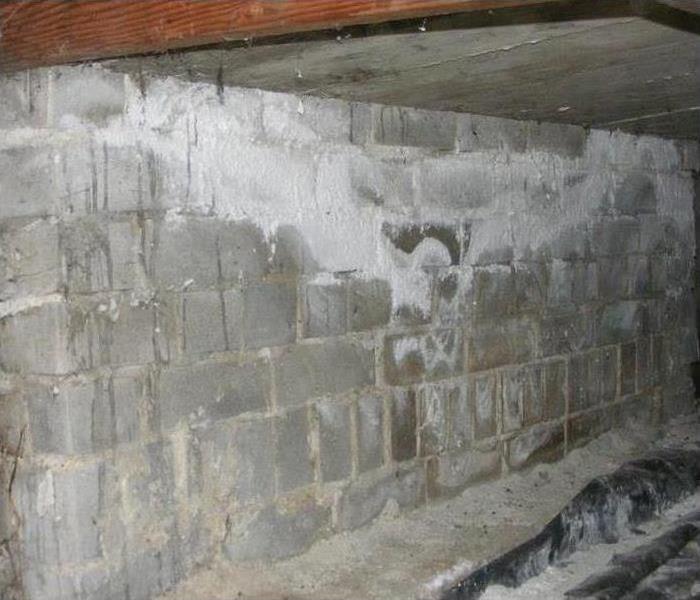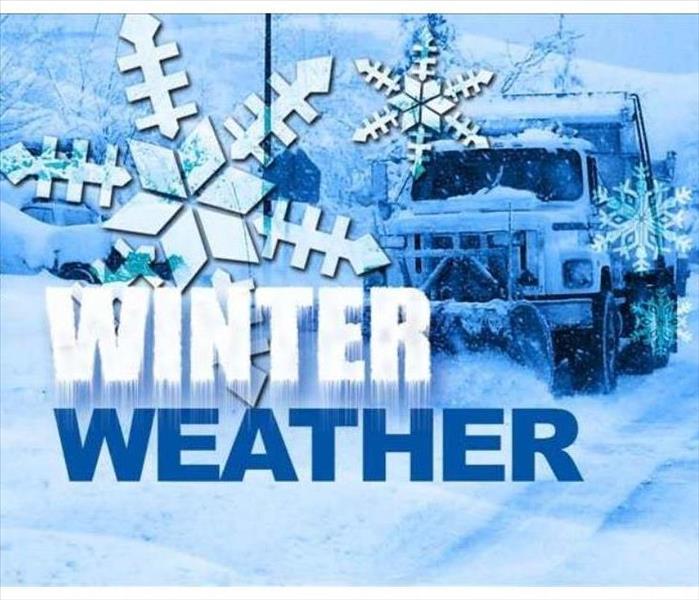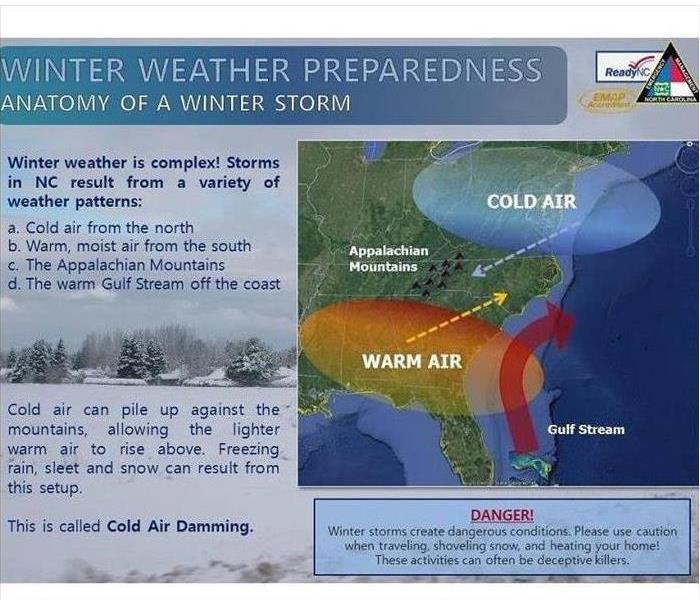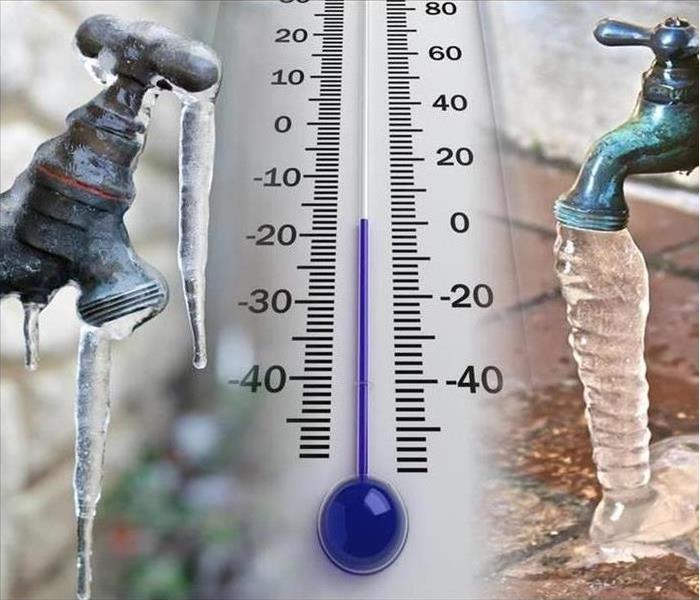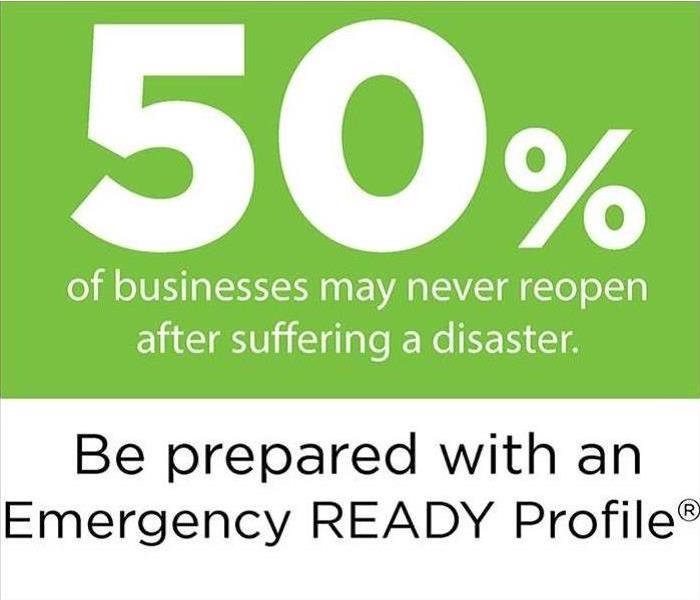Archived General Blog Posts
Winter storm hazards
1/13/2021 (Permalink)
Ice dams can be a major problem during the winter season. Cold weather, snow, and ice storms can cause severe damage to your home or your office.
Ice dams form when the heated air melts the roof snow downward and the melted water runs into ice that is still frozen causing the water to dam up. When this water is trapped, it can not flow or run into the gutter system and can backflow under the roof shingles and into the interior structure of your house or business.
Ice Dam damage:
Water can seep into your home or building’s walls, ceilings, insulation, and other interior areas.
Ice dams can lift roof shingles causing water to leak into your home.
Pressure and weight from the dams can pull off your gutters and lead to structural damage.
Our friends at Nationwide blog about Preventing Ice Dam Damage to Your Roof and Home.
If this disaster strikes, you need to take immediate action to prevent additional damage to your property. SERVPRO of Suffolk/Smithfield/Franklin franchise professionals have the winter storm experience and expertise, and the resources to remediate damage caused by winter weather. 757-934-8404
Efflorescence, is it harmful?
10/20/2020 (Permalink)
According to The Masonry Institute of America, Efflorescence is the white chalky powder that you might find on the surface of a concrete or brick wall. It can be a cosmetic issue, or it can be an indication of moisture intrusion that could lead to major structural and indoor air quality issues. Efflorescence (which means "to flower out" in French) is the dissolved salts deposited on the surface of a porous material that is visible after the evaporation of the water.
Porous materials like brick, stone, concrete, and wood have the ability to wick up water. If the water contains salt, once the water evaporates from the building materials it leaves behind efflorescence.
Efflorescence can often be confused with mold. However, not to worry, this is not toxic or harmful.
The best way to remove efflorescence is by acid washing the area. After the wash is complete, neutralize the area with baking soda. You want to make sure to neutralize the area because acid residue can be harmful to plants and animals.
If you have efflorescence that you would like to have looked at and cleaned up we are here to help. Give us a call, SERVPRO of Suffolk/Smithfield/Franklin, 757-934-8404.
Be prepared!
1/2/2020 (Permalink)
Prepare Your Home
Tips for Preparing Your Home for Winter Weather
- Keep your cabinet doors open during cold spells as this will allow warm air to circulate around the pipes.
- Keep a slow trickle of water running through your faucets, especially those that run through unheated or uninsulated areas of your home.
- Consider shutting off your outdoor faucets. Find the shut-off valve in the basement or crawl space and turn to “off.”
- If you do shut off your outdoor faucet, then open the outdoor faucet to help ensure it drains completely and the inner valve is shut off.
- Ensure that your gutters are clean and in good shape, secured. Leaves and such can clog and cause a damming effect which could lead to roof problems and water damage.
- Proper maintenance of your furnace, HVAC system can help reduce the risk of puff backs.
SERVPRO of Suffolk/Smithfield/Franklin is available 24 hours a day, 757-934-8404.
What is Efflorescence, and is it harmful?
10/28/2019 (Permalink)
According to The Masonry Institute of America, Efflorescence is the white chalky powder that you might find on the surface of a concrete or brick wall. It can be a cosmetic issue, or it can be an indication of moisture intrusion that could lead to major structural and indoor air quality issues. Efflorescence (which means "to flower out" in French) is the dissolved salts deposited on the surface of a porous material that are visible after the evaporation of the water.
Porous materials like brick, stone, concrete, and wood have the ability to wick up water. If the water contains salt, once the water evaporates from the building materials it leaves behind efflorescence.
Efflorescence can often be confused with mold. However, not to worry, this is not something that is toxic or harmful.
The best way to remove efflorescence is by acid washing the area. After the wash is complete, neutralize the area with baking soda. You want to make sure to neutralize the area because acid residue can be harmful to plants and animals.
If you have efflorescence that you would like to have looked at and cleaned up we are here to help. Give us a call, SERVPRO of Suffolk/Smithfield/Franklin, 757-934-8404.
Preparing for Winter Weather
1/2/2019 (Permalink)
Prepare Your Home
Tips for Preparing Your Home for Winter Weather
- Keep your cabinet doors open during cold spells as this will allow warm air to circulate around the pipes.
- Keep a slow trickle of water running through your faucets, especially those that run through unheated or uninsulated areas of your home.
- Consider shutting off your outdoor faucets. Find the shut-off valve in the basement or crawl space and turn to “off.”
- If you do shut off your outdoor faucet, then open the outdoor faucet to help ensure it drains completely and the inner valve is shut off.
- Ensure that your gutters are clean and in good shape, secured. Leaves and such can clog and cause a damming effect which could lead to roof problems and water damage.
- Proper maintenance of your furnace, HVAC system can help reduce the risk of puffbacks.
SERVPRO of Suffolk/Smithfield/Franklin is available 24 hours a day, 757-934-8404.
Winter Weather Hazards
1/2/2018 (Permalink)
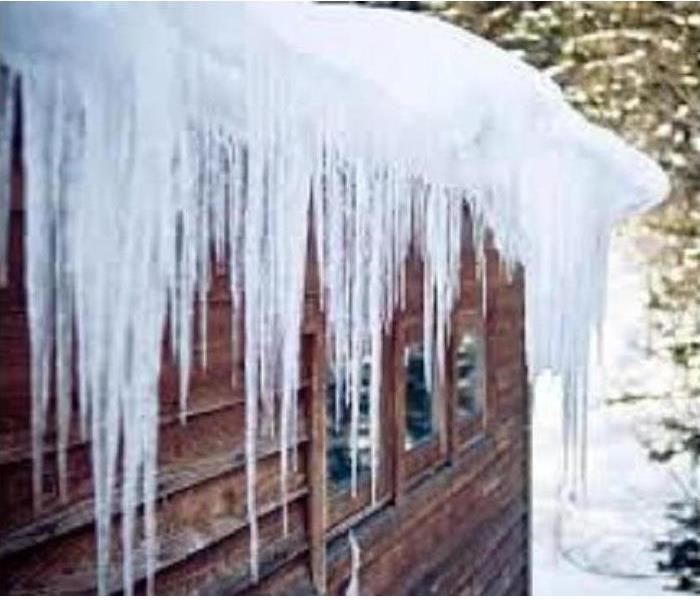 SERVPRO of Suffolk 757-934-8404
SERVPRO of Suffolk 757-934-8404
Ice dams can be a major problem during the winter season. Cold weather, snow and ice storms can cause severe damage to your home or your office.
Ice dams form when the heated air melts the roof snow downward and the melted water runs into ice that is still frozen causing the water to dam up. When this water is trapped, it can not flow or run into the gutter system and can backflow under the roof shingles and into the interior structure of your house or business.
Ice Dam damage:
- Water can seep into your home or building’s walls, ceilings, insulation and other interior areas.
- Ice dams can lift roof shingles causing water to leak into your home.
- Pressure and weight from the dams can pull off your gutters and lead to structural damage.
Our friends at Nationwide blog about Preventing Ice Dam Damage to Your Roof and Home.
If this disaster strikes, you need to take immediate action to prevent additional damage to your property. SERVPRO of Suffolk/Smithfield/Franklin franchise professionals have the winter storm experience and expertise, and the resources to remediate damage caused by winter weather.
Be Prepared for Winter Weather
1/2/2018 (Permalink)
Prepare Your Home
Tips for Preparing Your Home for Winter Weather
- Keep your cabinet doors open during cold spells as this will allow warm air to circulate around the pipes.
- Keep a slow trickle of water running through your faucets, especially those that run through unheated or uninsulated areas of your home.
- Consider shutting off your outdoor faucets. Find the shut-off valve in the basement or crawl space and turn to “off.”
- If you do shut off your outdoor faucet, then open the outdoor faucet to help ensure it drains completely and the inner valve is shut off.
- Ensure that your gutters are clean and in good shape, secured. Leaves and such can clog and cause a damming effect which could lead to roof problems and water damage.
- Proper maintenance of your furnace, HVAC system can help reduce the risk of puffbacks.
SERVPRO of Suffolk/Smithfield/Franklin is available 24 hours a day, 757-934-8404.
Smoke Detector's Save Lives!
2/24/2017 (Permalink)
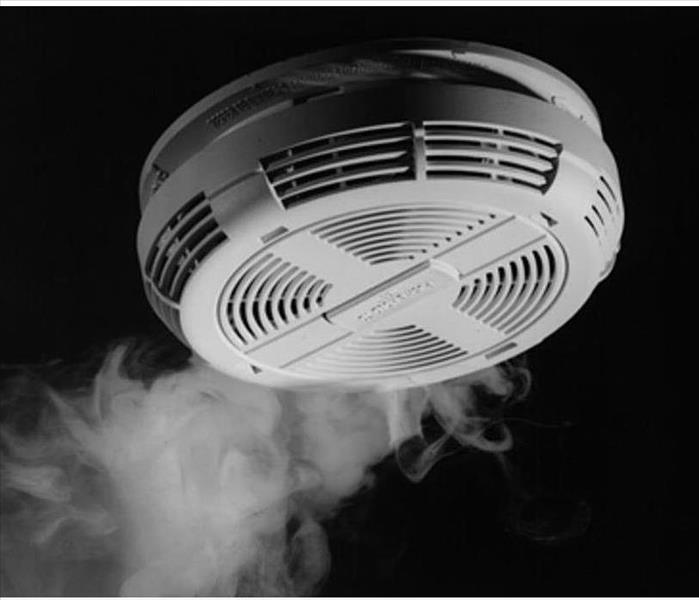 Smoke detectors save lives!
Smoke detectors save lives!
Smoke detectors/alarms play a vital role in saving lives, and when properly installed, can reduce the risk of fire injury in half.* The National Fire Protection Association recommends smoke alarms be installed in every bedroom, outside all sleeping quarters and on every level of the house. Business owners should consult the local Fire Marshall to ensure specific building fire codes and smoke detector requirements are met.
Smoke detectors work best when paired with a fire escape plan. A plan allows your family, employees or clients to escape quickly and safely in an emergency situation.
SMOKE ALARM SAFETY TIPS:
Review the following tips regarding smoke detector installation and maintenance.
-Install smoke detectors on every level of the home, including the basement.
-Smoke detectors should be installed away from the kitchen to prevent false alarms.
Generally, they should be at least 10 feet from a cooking appliance.
-Test smoke detectors at least once a month using the test button.
-Replace batteries in all smoke detectors at least once a year. If an alarm “chirps,” the battery is low and should be replaced right away.
-Replace all smoke detectors when they are 10 years old.
*Tips and statistics provided by the National Fire Protection Association.
How to Prepare for Winter Weather and Avoid Water Damage
1/23/2017 (Permalink)
As seasons change, so do property owners preparation checklists. With winter weather upon us, it is important for homeowners and property managers to do everything they can do to reduce risks of costly water damage caused by frozen pipes.
When water freezes, it expands. That’s why a can of soda explodes if it’s put into a freezer to chill quickly and then forgotten. When water freezes in a pipe, it expands the same way. If it expands enough, the pipe bursts and water escapes leaving serious damage as a result.
Pipes in attics, crawlspaces, and outside walls are all vulnerable to freezing, especially if there are cracks or openings that allow the cold, outside air to flow across the pipes. Holes in an outside wall where television, cable or telephone lines enter can provide access for cold air to reach pipes.
The Red Cross warns that pipe freezing is likely to occur after consecutive days and nights of freezing (32 degrees) or below conditions. Taking the following precautions ahead of time can help you prevent potential pipe catastrophes:
- Keep a slow trickle of water flowing through faucets, especially if the pipes for faucets run through unheated or uninsulated areas of your home. Allowing cold water to trickle from a faucet can alleviate pressure and prevent a rupture even if freezing occurs.
- If a vacant home, keep the temperature above 65 degrees.
- Cap outdoor water fixtures. By placing a cover on outdoor spigots and faucets, it reduces the possibility these fixtures build up with ice.
- Keep cabinet doors open during cold spells. This allows warm air to circulate around pipes.
If you have done nothing to prevent frozen pipes and you have water leaking or you have no water pressure, it likely means your pipes have burst. According to State Farm Insurance, this happens to more than 50 million families each year in the United States. If a pipe has even 1/8” crack, it can release 250 gallons of water a day.
You must act fast to prevent further, and more costly damage.
- This first step is to always shut down your property’s main water supply. (Depending on the amount of water and location, you may want to first turn off electricity.)
- If it’s heated water that’s coming from the broken pipe, you should also close the valve attached to your hot water heater.
- After you’ve shut down the water, call a plumber for help with repairing or replacing the burst pipe.
Make SERVPRO of Suffolk/Smithfield/Franklin your first call to help you and your local insurance agent assess the damage. We will work for you to restore your property and your life to make it Like It Never Happened®.
Be Prepared!!
1/23/2017 (Permalink)
If a disaster happens, are you READY! No one ever plans for a disaster, but you can prepare for it. SERVPRO® has an Emergency READY Profile (ERP) that will help ensure you are “Ready for whatever happens” in 2017. Here are a few advantages for having an ERP for your commercial building:
• No cost
• A concise profile documenting critical information in an event of an emergency
• A guide to help you get back into your work space following a disaster
• Identification of the line of command for authorizing work to begin
• It provides facility details such as water shut-off valves locations, breaker box locations, and other priority details
• It provides priority contact information for your business
Preparation is key to making it through a disaster. Don’t wait until disaster strikes, be ready and call SERVPRO® of Suffolk/Smithfield/Franklin today to establish your Emergency Ready Profile!





 24/7 Emergency Service
24/7 Emergency Service
